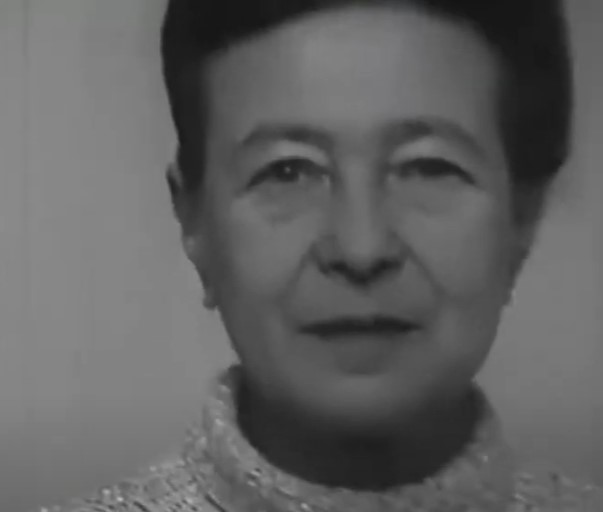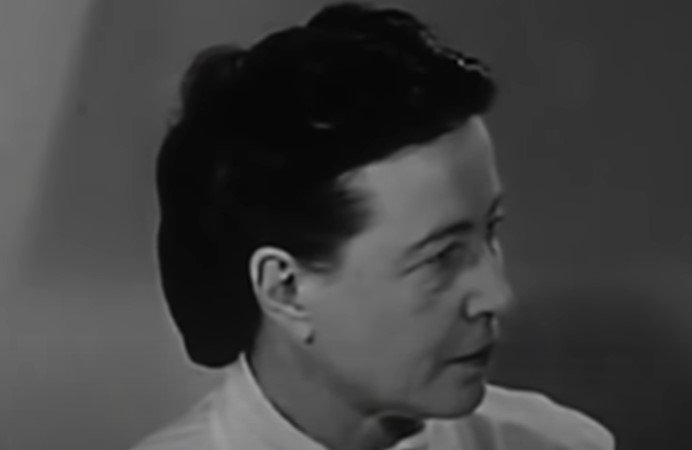SIMONE DE BEAUVOIR

WHO WAS SIMONE DE BEAUVOIR?
Simone de Beauvoir was a French writer and feminist who was a member of the intellectual fellowship of philosopher-writers who gave a literary transcription of the concepts of existentialism. She was born on January 9, 1908, in Paris, France, and passed away on April 14, 1986, in Paris.
Her essay Le Deuxième Sexe, which was published in two volumes in 1949 and was titled The Second Sex, is the primary reason for her notoriety. It is a scholarly and passionate argument for the elimination of what she referred to as the “eternal feminine notion.” It is now considered a classic piece of feminist literature.
Simone De Beauvoir received her education in private institutions before enrolling at the Sorbonne. It was there that she received her agrégation in philosophy in 1929. It was then that she initiated a relationship with Jean-Paul Sartre that would last for the rest of her life. She was a teacher at a number of schools from the years 1931 to 1943 before she began writing as her primary source of income. Together with Sartre, she established and started editing a monthly review of Le Temps modernes in 1945. Her works of fiction elaborate on the most significant existential topics, so illustrating her understanding of the writer’s dedication to the times.
Simone De Beauvoir’s Formative Years
Simone De Beauvoir was born in Paris, France, on January 9, 1908. She was the first of two daughters who were born to Georges and Francoise de Beauvoir, who were of the middle-class social structure. Her mother was the daughter of a wealthy banker and a devout Catholic. Her father was a legal secretary who did not have any religious convictions, and her mother was a strong believer in the Catholic faith.
Following World War I (1914–18), her father experienced financial difficulties, which resulted in the family relocating to a more compact residence. In spite of the fact that the family had lost their income in the years following World War I, Simone and her sister were offered admission to a prominent convent school.

Simone de Beauvoir attended the Institut Catholique de Paris and the Institut Sainte-Marie after she had successfully completed her bachelor examinations in the subjects of mathematics and philosophy in the year 1925.
Following her graduation from the Institut Catholique in 1925 with a Bachelor of Arts degree not just in mathematics but also in philosophy, she went on to pursue further education at the Sorbonne. In addition to obtaining certifications in Greek, logic, ethics, sociology, and psychology, de Beauvoir spent time there studying philosophy and completing exams to earn those certificates.
As a result of her writing a thesis on Leibniz, she achieved the distinction of being the youngest person to ever pass the philosophy aggregation examination. Subsequently, she emerged as the youngest philosophy instructor in France at the age of twenty-one. This is where she made the acquaintance of Jean-Paul Sartre, a fellow student who had triumphed in the examination. She went on to pursue further education at the Sorbonne, where she eventually earned her degree in 1928.
Simone De Beauvoir’s Professional Writing Career
- Collaboration with Sartre
During the year 1933, Simone de Beauvoir and Jean Paul Sartre made an attempt to engage in a ménage à trois with Olga Kosakiewicz, who was another student of Sartre. The sorrow that was produced by this experiment served as the inspiration for de Beauvoir’s first novel, which was published in 1943 and titled She Came to Stay. The narrative effectively portrays the intense and stifling environment created by the trio, as the lethargic interloper Xaviére gradually ruins everything in her vicinity.
During the 1930s, Simone De Beauvoir’s life was largely that of a provincial professor who had intellectual leanings, a large circle of friends, and a lifestyle that was somewhat bohemian. During World War II, Sartre spent nine months as a prisoner of war after being drafted to serve in the French army. Upon his return in 1941, he and De Beauvoir made the decision to become more involved in public life during the time that Germany was occupying France.
After deciding to devote themselves to writing and, frequently, political engagement, both of them left their academic positions. Additionally, during the 1940s, De Beauvoir penned the play Who Shall Die? in addition to editing and writing pieces for the periodical Les Temps Modernes, which she and Sartre had established in order to serve as a platform for their respective beliefs. Several excerpts from The Second Sex, which is considered to be De Beauvoir’s most famous piece of writing, were initially published in this monthly review.
- The Prime of Life
Even though De Beauvoir was already one of the most prominent feminist figures of her time before writing The Second Sex, the book has occasionally taken precedence over her prolific career, which encompassed not only fiction but also travel writing, autobiography, philosophy, and political activism. Other important works include the trip books America Day by Day (1948) and The Long March (1957), as well as four autobiographies.
In addition to her many literary and philosophical achievements, de Beauvoir was not content to sit on her laurels and used her fame to speak out on politics. During the 1950s, she joined forces with Sartre to support the movements for independence of Algeria and Hungary, as well as the student movement in France during the late 1960s. She was quite vocal in her condemnation of the foreign policy that the United States government pursued throughout the Vietnam War.
During the 1970s, De Beauvoir’s work propelled her to the forefront of the feminist movement. She contributed her intelligence to the movement by giving lectures and writing essays, as well as by taking part in rallies for the rights of women and the right to have abortions.
The Second Sex Summary
Simone De Beauvoir’s The Second Sex, published in 1949, is a comprehensive critique of patriarchy and the subordinate position that women have been assigned throughout history. The book spans about 1,000 pages. Despite the fact that it is now considered to be one of the most significant and early works of feminism, The Second Sex was met with a great deal of controversy when it was first published. Some critics referred to the book as pornography, and the Vatican included it on the list of writings that are prohibited by the church.
The first English-language edition of The Second Sex was released in the United States four years after the original publication, however, it is usually considered to be a pale imitation of the original. The year 2009 saw the publication of a significantly more faithful and unedited English volume, which served to further solidify De Beauvoir’s already substantial reputation as one of the most influential philosophers of the contemporary feminist movement.
- Additional Contributions to Philosophy and Feminism
In addition, Simone penned the piece titled The Mandarins in the year 1954. It was the latter novel that earned her the coveted Prix Goncourt medal in the same year, and it was praised by Iris Murdoch, a well-known British author and philosopher, as being charming due to the fact that it maintained a serious tone throughout.
Simone De Beauvoir presented the concept of existentialist ethics in a straightforward manner in her philosophical essay titled The Ethics of Ambiguity, which she published in 1947. She did this by drawing a connection between the predicament of having unlimited freedom and the limitations that are imposed by a variety of varied circumstances. Her conclusion revealed her radical perspective on freedom, which asserted that the existence of humans comprises a finiteness that is open to boundless possibilities.
Simone De Beauvoir’s Personal Life
At one point in time, Simone De Beauvoir entertained the idea of getting married to her cousin Jacques Champigneulle; however, this never materialized. While she never tied the knot, she stayed in a committed relationship with the renowned philosopher Jean Paul Sartre from October 1929 to the present day. Sartre and de Beauvoir were romantically involved and maintained a strong collaboration throughout their relationship; yet, they never lived together.
Marriage was not something they were interested in, and neither of them desired to have children. On top of that, they did not exclude what they referred to as “contingent” affairs, some of which became significant in their lives. Beauvoir adopted Sylvie Le Bon. As Beauvoir’s adoptive daughter, she became her literary heir.
Old Age and Demise
In the later stages of her work, Simone De Beauvoir focused a significant amount of her thought on the investigation of mortality and the process of aging. Her works include A Very Easy Death from 1964 which describes the departure of her mother, Old Age from 1970 examines the relevance and meaning of the old in society, and Adieux: A Farewell to Sartre from 1981, which was released as year after his death, recalls the final years of her partner’s life.
The death of Simone De Beauvoir occurred on April 14, 1986, in Paris. She was 78 years old. It was pneumonia that ultimately led to her passing. The Montparnasse Cemetery in Paris is where she is laid to rest close to her lifelong companion Jean-Paul Sartre, who passed away on April 15, 1980, at the age of 74.
